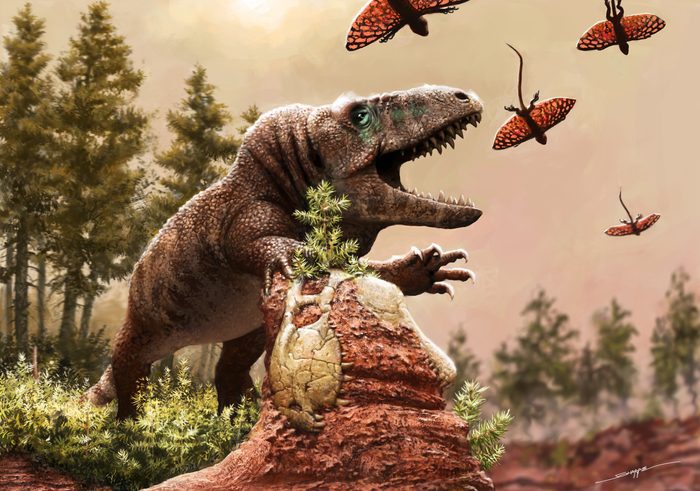Just over 250 million years ago during the end of the Permian period and start of the Triassic, reptiles had one heck of a coming out party.

Credit: Henry Sharpe
Just over 250 million years ago during the end of the Permian period and start of the Triassic, reptiles had one heck of a coming out party.
Their rates of evolution and diversity started exploding, leading to a dizzying variety of abilities, body plans, and traits, and helping to firmly establish both their extinct lineages and those that still exist today as one of the most successful and diverse animal groups the world has ever seen. For the longest time, this flourish was explained by their competition being wiped out by two of the biggest mass extinction events (around 261 and 252 million years ago) in the history of the planet.
A new Harvard-led study has rewritten that explanation by reconstructing how the bodies of ancient reptiles changed and by comparing it against millions of years of climate change.
Harvard paleontologist Stephanie Pierce’s lab shows that the morphological evolution and diversification seen in early reptiles not only started years before these mass extinction events but instead were directly driven by what caused them in the first place — rising global temperatures due to climate change.
“We are suggesting that we have two major factors at play — not just this open ecological opportunity that has always been thought by several scientists — but also something that nobody had previously come up with, which is that climate change actually directly triggered the adaptive response of reptiles to help build this vast array of new body plans and the explosion of groups that we see in the Triassic,” said Tiago R. Simões, a postdoctoral fellow in the Pierce lab and lead author on the study.
“Basically, [rising global temperatures] triggered all these different morphological experiments — some that worked quite well and survived for millions of years up to this day, and some others that basically vanished a few million years later,” Simões added.
In the paper, which published Friday in Science Advances, the researchers lay out the vast anatomical changes that took place in many reptile groups, including the forerunners of crocodiles and dinosaurs, in direct response to major climate shifts concentrated between 260 to 230 million years ago.
The study provides a close look at how a large group of organisms evolve because of climate change, which is especially pertinent today as temperatures continually rise. In fact, the rate of carbon dioxide released into the atmosphere today is about nine times what they were during the timeframe that culminated in the biggest climate change-driven mass extinction of all time 252 million years ago: the Permian-Triassic mass extinction.
“Major shifts in global temperature can have dramatic and varying impacts on biodiversity,” said Stephanie E. Pierce, Thomas D. Cabot Associate Professor of Organismic and Evolutionary Biology and curator of vertebrate paleontology in the Museum of Comparative Zoology. “Here we show that rising temperatures during the Permian-Triassic led to the extinction of many animals, including many of the ancestors of mammals, but also sparked the explosive evolution of others, especially the reptiles that went on to dominate the Triassic period.”
The study involved close to eight years of data collection and took a heavy dose of camerawork, CT scanning, and loads of passport stamps as Simões traveled to more than 20 countries and more than 50 different museums to take scans and snapshots of more than 1,000 reptilian fossils.
With all the information, the researchers created an expansive dataset that was analyzed with state-of-the-art statistical methods to produce a diagram called an evolutionary time tree. Time trees reveal how early reptiles were related to each other, when their lineages first originated, and how fast they were evolving. They then combined it with global temperature data from millions of years ago.
Diversification of reptile body plans started about 30 million years before the Permian-Triassic extinction, making it clear these changes weren’t triggered by the event as previously thought. The extinction events did help put them in gear though.
The dataset also showed that rises in global temperatures, which started at about 270 million years ago and lasted until at least 240 million years ago, were followed by rapid body changes in most reptile lineages. For instance, some of the larger cold-blooded animals evolved to become smaller so they could cool down easier; others evolved to life in water for that same effect. The latter group included some of the most bizarre forms of reptiles that would go on to become extinct such as a giant, long-necked marine reptile once thought to be the Loch Ness monster, a tiny chameleon-like creature with a bird-like skull and beak, and a gliding reptile resembling a gecko with wings. It also includes the ancestors of reptiles that still exist today like turtles and crocodiles.
Smaller reptiles, which gave rise to the first lizards and tuataras, went on a different path than their larger reptile brethren. Their evolutionary rates slowed down and stabilized in response to the rising temperatures. The researchers believe it was because the small-bodied reptiles were already better adapted to the rising heat since they can more easily release heat from their bodies compared to larger reptiles when temperatures got hot very quickly all-around Earth.
The researchers say they are planning to expand on this work investigating the impact of environmental catastrophes on evolution of organisms with abundant modern diversity, such as the major groups of lizards and snakes.
Journal
Science Advances
DOI
10.1126/sciadv.abq1898
Method of Research
Computational simulation/modeling
Subject of Research
Animals
Article Title
Successive climate crises in the deep past drove the early evolution and radiation of reptiles
Article Publication Date
19-Aug-2022




